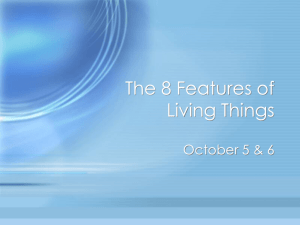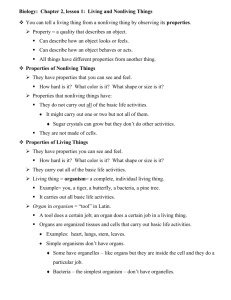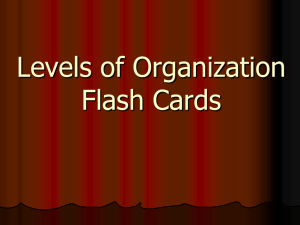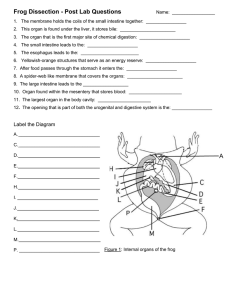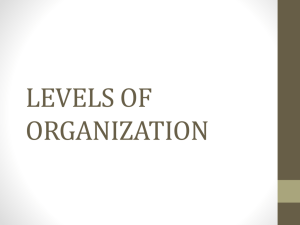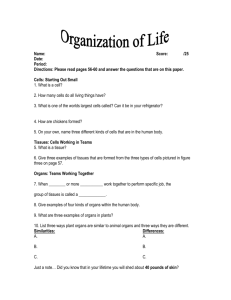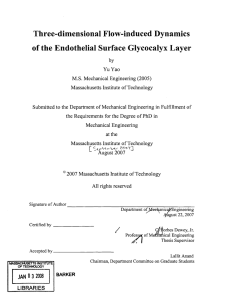A. Cells - lhsmedley
advertisement
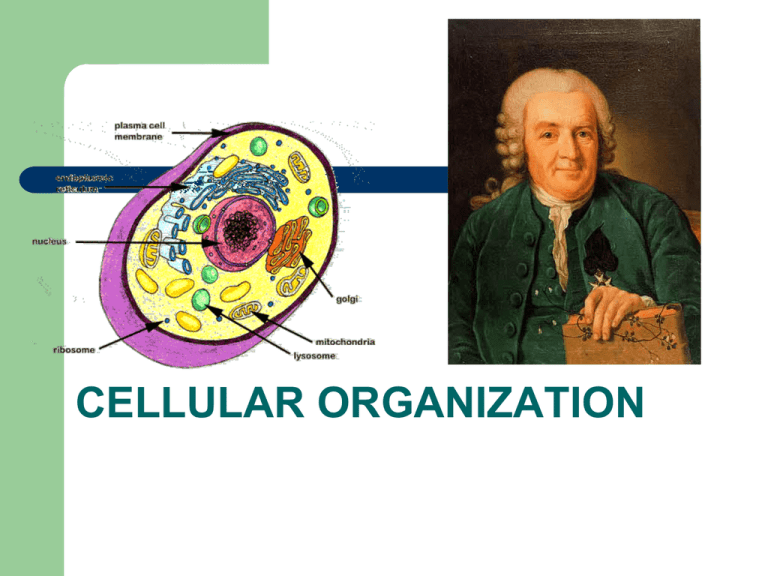
CELLULAR ORGANIZATION Cells, Tissues, Organs, & Organ Systems of Animals Some animals are single-celled (unicellular) Some are made of many cells (multicellular) Everything that an animal does is ultimately happening at the cellular level. I. Levels of Specialization Cells Tissues Organs Organ Systems Organism A. Cells – the smallest functional unit of life 1. Eukaryote – organism with a nucleus, membranebound organelles, and more than one chromosome. Ex. – anything BUT bacteria 2. Prokaryote – independent, unicellular organism with NO nucleus, NO membrane-bound organelles, and circularstranded DNA. Ex. – bacteria 3. Origin of Eukaryotes The Endosymbiont Hypothesis: – – – i. the first cells on Earth were most likely very simple prokaryotes. ii. The eukaryotic cell might have evolved when a large ANAEROBIC prokaryote ingested smaller bacteria and stabilized them instead of digesting them. This AEROBIC bacteria developed into mitochondria. Flagella may have arisen through the ingestion of spiral-shaped bacteria called spirochetes. Chloroplasts most likely evolved from the ingestion of prokaryotes that resembled present-day photosynthetic cyanobacteria. Video Why are most cells so small? As the radius of a cell increases, the volume of the cell increases faster than the surface area. If the volume becomes too large, the intake of nutrients and output of wastes can’t keep up. Video The yolk of an ostrich egg is the largest cell in existence today! B. Tissues A group of similar cells specialized for the performance of a common function. – – – – 1. Epithelial 2. Connective and Blood 3. Muscle 4. Nervous C. Organs Several different types of tissue working together to perform a common function. Ex. – heart, lungs, liver, kidneys, brain, skin D. Organ System A group of organs working together to perform a specific function Skeletal System – provides protection for internal organs; serves as an attachment site for muscles, tendons, and ligaments. Circulatory System – brings oxygen to all cells of the body and delivers waste to the kidneys. Integumentary System provides protection against water and heat loss; acts as a barrier between the body and the outside world. Excretory System – gets rid of excess water, waste, and toxins accumulated in the body. Endocrine System – regulates the production of hormones in the body. Digestive System – breaks down food and delivers nutrients to the bloodstream. E. Organism All the organ systems working together to maintain a complete living thing. II. Cell Membranes A. Structure: Fluid-Mosaic Model – portrays the cell membrane as a thick liquid or gel in which specific proteins float like ice burgs. – – 1. Phospholipid Bilayer – has one polar end and one nonpolar end. The nonpolar, hydrophobic, tails of each molecule face each other to form the “filling of the sandwich”. The polar, hydrophilic, heads form the “bread”. The heads are phosphate, the tails are lipid. Hence, phospholipid bilayer. Coloring Page Structure Continued 2. Cholesterol molecules embedded in the bilayer give it more of a rigid structure. 3. Carbohydrates attach to the bilayer itself, forming glycolipids, or to the floating proteins, forming glycoproteins. The combination of glycolipids and glycoproteins is called the glycocalyx. Every cell has its own unique glycocalyx, thus it is termed the cell’s “fingerprint”. This fingerprint allows for coordinating cell behavior and communication between cells. Coloring Page B. Functions 1. Regulates material moving in or out of the cell. – i. selective permeability – lets some things in but keeps others out; essential for maintaining homeostasis. Functions Continued 2. Provides surface area for chemical reactions to occur. 3. Serve as receptor sites (glycocalyx). Movement of H2O Across the Cell Membrane - Osmosis Osmosis – movement of water, from a high concentration to a low concentration; requires no energy input – – – 1. isotonic – the solute (salt, sugar, etc) concentration is the same both inside and outside the cell. 2. hypertonic (more H2O) – higher concentration of water inside the cell, so it moves to a lower concentration OUT of the cell 3. hypotonic (less H2O) – low concentration of water inside the cell, so water moves INTO the cell to even it out. III. Movement Across Membranes A. Simple Diffusion – molecules randomly move from areas of high concentration to low concentration. Requires no energy input. Ex. – spraying air freshener through the fence of a tennis court. B. Facilitated Diffusion – a molecule diffuses through a protein channel. Still moving from a high to low concentration gradient requiring no energy input. Ex. Walking through the gate onto a tennis court. Movement Across Membranes Cont’d D. Filtration – uses water pressure or blood pressure to force small molecules across a membrane; requires no energy input. E. Active Transport – moves molecules AGAINST the concentration gradient for LOW to HIGH; requires ATP (energy). Ex. – forcing yourself through the gate of an extremely crowded tennis court. Movement Across Membranes Cont’d F. Endocytosis – involves the movement of large or multiple substances into the cell. – – – 1. pinocytosis – the intake of fluid, “cell drinking”; arms of the cell surround the liquid and pull it in. 2. phagocytosis – the intake of solids, “cell eating”; arms of the cell surround the material and bring it in. 3. receptor-mediated endocytosis – involves a specific receptor protein on the cell membrane (glycocalyx) that recognizes the molecule and binds with it, allowing it access into the cell. Then, the arms of the cell surround the material and bring it in. Movement Across Membranes Cont’d Exocytosis – the movement of materials out of the cell
